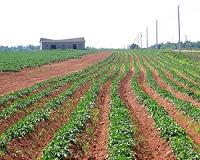 |
Stanford CA (SPX) Jan 25, 2011 Plant biologists have discovered the last major element of the series of chemical signals that one class of plant hormones, called brassinosteroids, send from a protein on the surface of a plant cell to the cell's nucleus. Although many steps of the pathway were already known, new research from a team including Carnegie's Ying Sun and Zhiyong Wang fills in a missing gap about the mechanism through which brassinosteroids cause plant genes to be expressed. Their research, which will be published online by Nature Cell Biology, has implications for agricultural science and, potentially, evolutionary research. "Brassinosteroids are found throughout the plant kingdom and regulate many aspects of growth and development, as well as resistance from external stresses," said Wang. "Mutant plants that are deficient in brassinosteroids show defects at many phases of the plant life cycle, including reduced seed germination, irregular growth in the absence of light, dwarfism, and sterility." Previous research had identified a pathway of chemical signals that starts when a brassinosteroid binds to a receptor on the surface of a plant cell and activates a cascade of activity that consists of adding and removing phosphates from a series of proteins. When brassinosteroids are not present, a protein in this pathway called BIN2 acts to add phosphates to two other proteins called BZR1 and BZR2, which are part of a special class of proteins called transcription factors. The phosphates inhibit the transcription factors. But when a brassinosteroid binds to the cell-surface receptor, BIN2 is deactivated, and as a result phosphates are removed from the two transcription factors. As a result, BZR1 and BZR2 can enter the cell's nucleus, where they bind directly to DNA molecules and promote a wide variety of gene activity. Before this new research, the protein that detaches the phosphates and allows BZR1 and BZR2 to work was unknown. Using an extensive array of research techniques, the team was able to prove that a protein called protein phosphatase 2A (PP2A) is responsible. "We discovered that PP2A is a key component of the brassinosteroid signaling pathway," Wang said. "This discovery completes the core signaling module that relays extracellular brassinosteroids to cue activity in the nucleus." Further research is needed to determine whether brassinosteroid binding activates PP2A, or just deactivates BIN2, thus allowing PP2A to do this job. Additionally, PP2A is involved in a plant's response to gravity and light, among other things. This aspect of the brassinosteroid signaling pathway bears some surprising resemblances to signaling pathways found in many members of the animal kingdom. More research could demonstrate details of the evolutionary split between non-protozoan animals and plants. This work was financially supported by the Division of Chemical Sciences, Geosciences, and Biosciences, Office of Basic Energy Sciences of the US Department of Energy, as well as by NIH, the National Science Foundation of China, and the Herman Frasch Foundation. Some of the researchers were supported by the China Scholarship Council. The UCSF Mass Spectrometry Facility, where some of the research was conducted, is supported by the Biomedical Research Technology Program of the National Centre for Research Resources, NIH.
Share This Article With Planet Earth
Related Links Carnegie Institution Farming Today - Suppliers and Technology
 Toward Controlling Fungus That Caused Irish Potato Famine
Toward Controlling Fungus That Caused Irish Potato FamineWashington DC (SPX) Jan 21, 2011 Scientists are reporting a key advance toward development of a way to combat the terrible plant diseases that caused the Irish potato famine and still inflict billions of dollars of damage to crops each year around the world. Their study appears in ACS' bi-weekly journal Organic Letters. Teck-Peng Loh and colleagues point out that the Phytophthora fungi cause extensive damage to food ... read more |
|
| The content herein, unless otherwise known to be public domain, are Copyright 1995-2010 - SpaceDaily. AFP and UPI Wire Stories are copyright Agence France-Presse and United Press International. ESA Portal Reports are copyright European Space Agency. All NASA sourced material is public domain. Additional copyrights may apply in whole or part to other bona fide parties. Advertising does not imply endorsement,agreement or approval of any opinions, statements or information provided by SpaceDaily on any Web page published or hosted by SpaceDaily. Privacy Statement |